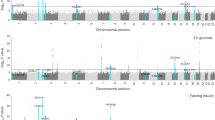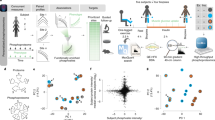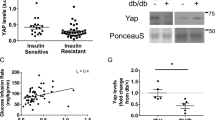Abstract
DNA microarrays can be used to identify gene expression changes characteristic of human disease. This is challenging, however, when relevant differences are subtle at the level of individual genes. We introduce an analytical strategy, Gene Set Enrichment Analysis, designed to detect modest but coordinate changes in the expression of groups of functionally related genes. Using this approach, we identify a set of genes involved in oxidative phosphorylation whose expression is coordinately decreased in human diabetic muscle. Expression of these genes is high at sites of insulin-mediated glucose disposal, activated by PGC-1α and correlated with total-body aerobic capacity. Our results associate this gene set with clinically important variation in human metabolism and illustrate the value of pathway relationships in the analysis of genomic profiling experiments.
This is a preview of subscription content, access via your institution
Access options
Subscribe to this journal
Receive 12 print issues and online access
$209.00 per year
only $17.42 per issue
Buy this article
- Purchase on SpringerLink
- Instant access to full article PDF
Prices may be subject to local taxes which are calculated during checkout




Similar content being viewed by others
References
Zimmet, P. Globalization, coca-colonization and the chronic disease epidemic: can the Doomsday scenario be averted? J. Intern. Med. 247, 301–310 (2000).
Fajans, S.S., Bell, G.I. & Polonsky, K.S. Molecular mechanisms and clinical pathophysiology of maturity-onset diabetes of the young. N. Engl. J. Med. 345, 971–980 (2001).
Golub, T.R. et al. Molecular classification of cancer: class discovery and class prediction by gene expression monitoring. Science 286, 531–537 (1999).
Doniger, S.W. et al. MAPPFinder: using Gene Ontology and GenMAPP to create a global gene-expression profile from microarray data. Genome Biol. 4, R7 (2003).
Draghici, S., Khatri, P., Martins, R.P., Ostermeier, G.C. & Krawetz, S.A. Global functional profiling of gene expression. Genomics 81, 98–104 (2003).
Tusher, V.G., Tibshirani, R. & Chu, G. Significance analysis of microarrays applied to the ionizing radiation response. Proc. Natl. Acad. Sci. USA 98, 5116–5121 (2001).
Sreekumar, R., Halvatsiotis, P., Schimke, J.C. & Nair, K.S. Gene expression profile in skeletal muscle of type 2 diabetes and the effect of insulin treatment. Diabetes 51, 1913–1920 (2002).
Yang, X., Pratley, R.E., Tokraks, S., Bogardus, C. & Permana, P.A. Microarray profiling of skeletal muscle tissues from equally obese, non-diabetic insulin-sensitive and insulin-resistant Pima Indians. Diabetologia 45, 1584–1593 (2002).
Kropf, S. & Lauter, J. Multiple tests for different sets of variables using a data-driven ordering of hypotheses, with an application to gene expression data. Biometrical J. 44, 789–800 (2002).
Storey, J.D. A direct approach to false discovery rates. J. R. Statist. Soc. B 64, 479–498 (2002).
Liu, G. et al. NetAffx: Affymetrix probesets and annotations. Nucleic Acids Res. 31, 82–86 (2003).
Su, A.I. et al. Large-scale analysis of the human and mouse transcriptomes. Proc. Natl. Acad. Sci. USA 99, 4465–4470 (2002).
Bjorntorp, P., Schersten, T. & Fagerberg, S.E. Respiration and phosphorylation of mitochondria isolated from the skeletal muscle of diabetic and normal subjects. Diabetologia 3, 346–352 (1967).
Simoneau, J.A., Colberg, S.R., Thaete, F.L. & Kelley, D.E. Skeletal muscle glycolytic and oxidative enzyme capacities are determinants of insulin sensitivity and muscle composition in obese women. FASEB J. 9, 273–278 (1995).
Puigserver, P. et al. A cold-inducible coactivator of nuclear receptors linked to adaptive thermogenesis. Cell 92, 829–839 (1998).
Wu, Z. et al. Mechanisms controlling mitochondrial biogenesis and respiration through the thermogenic coactivator PGC-1. Cell 98, 115–124 (1999).
Lin, J. et al. Transcriptional co-activator PGC-1α drives the formation of slow- twitch muscle fibres. Nature 418, 797–801 (2002).
Scarpulla, R.C. Nuclear activators and coactivators in mammalian mitochondrial biogenesis. Biochim. Biophys. Acta 1576, 1–14 (2002).
Brown, G.C. Control of respiration and ATP synthesis in mammalian mitochondria and cells. Biochem. J. 284, 1–13 (1992).
Eriksson, K.F. & Lindgarde, F. Impaired glucose tolerance in a middle-aged male urban population: a new approach for identifying high-risk cases. Diabetologia 33, 526–531 (1990).
Kelley, D.E., He, J., Menshikova, E.V. & Ritov, V.B. Dysfunction of mitochondria in human skeletal muscle in type 2 diabetes. Diabetes 51, 2944–2950 (2002).
van Dam, R.M. & Feskens, E.J. Coffee consumption and risk of type 2 diabetes mellitus. Lancet 360, 1477–1478 (2002).
Ojuka, E.O., Jones, T.E., Han, D.H., Chen, M. & Holloszy, J.O. Raising Ca2+ in L6 myotubes mimics effects of exercise on mitochondrial biogenesis in muscle. FASEB J. 17, 675–681 (2003).
Florez, J.C., Hirschhorn, J.N. & Altshuler, D. The inherited basis of diabetes mellitus: general lessons for the genetic analysis of complex traits. Annu. Rev. Genomics Hum. Genet. (in the press).
Ek, J. et al. Mutation analysis of peroxisome proliferator-activated receptor-gamma coactivator-1 (PGC-1) and relationships of identified amino acid polymorphisms to Type II diabetes mellitus. Diabetologia 44, 2220–2226 (2001).
Hara, K. et al. A genetic variation in the PGC-1 gene and insulin resistance. Diabetologia 45, 740–743 (2002).
Lacquemant, C., Chikri, M., Boutin, P., Samson, C. & Froguel, P. No association between the G482S polymorphism of the proliferator-activated receptor-γ coactivator-1 (PGC-1) gene and Type II diabetes in French Caucasias. Diabetologia 45, 602–603; author reply 604 (2002).
Groop, L. et al. Metabolic consequences of a family history of NIDDM (the Botnia study): evidence for sex-specific parental effects. Diabetes 45, 1585–1593 (1996).
Eriksson, K.F., Saltin, B. & Lindgarde, F. Increased skeletal muscle capillary density precedes diabetes development in men with impaired glucose tolerance. A 15-year follow-up. Diabetes 43, 805–808 (1994).
Schalin-Jantti, C., Laurila, E., Lofman, M. & Groop, L.C. Determinants of insulin-stimulated skeletal muscle glycogen metabolism in man. Eur. J. Clin. Invest. 25, 693–698 (1995).
Tamayo, P. et al. Interpreting patterns of gene expression with self-organizing maps: methods and application to hematopoietic differentiation. Proc. Natl. Acad. Sci. USA 96, 2907–2912 (1999).
Eisen, M.B., Spellman, P.T., Brown, P.O. & Botstein, D. Cluster analysis and display of genome-wide expression patterns. Proc. Natl. Acad. Sci. USA 95, 14863–14868 (1998).
Acknowledgements
We thank C. Ladd, M. Gaasenbeek and G. Ahlqvist for technical assistance; L. Gaffney for preparing illustrations; D. Stram and R. Heinrich for discussions; M. Patti and colleagues for sharing their manuscript before publication; B. Gewurz, E. Rosen, members of D.A. and E.S.L.'s labs for comments on the manuscript; and the individuals who volunteered for this study. V.K.M. is supported by a Howard Hughes Medical Institute physician postdoctoral fellowship. C.M.L. was supported by the Foundation for Strategic Research, the Royal Physiographic Society, the Sven Lundgrens Foundation and the Albert Pahlssons Foundation. T.R.G. is an Investigator of the Howard Hughes Medical Institute. J.N.H. is the recipient of a Career Development Award of the Burroughs Welcome Fund. D.A. is a Clinical Scholar in Translational Research of the Burroughs Welcome Fund and a Charles E. Culpeper Scholar of the Rockefeller Brothers Fund. This work was supported in part by grants from Affymetrix, Millennium Pharmaceuticals and Bristol-Myers Squibb to E.S.L. and from the Sigrid Juselius Foundation, the Juvenile Diabetes Foundation-Wallenberg Foundation, the Swedish Medical Research Council, the Novo-Nordisk Foundation and a European Community Genomics Integrated Force for Type 2 Diabetes grant to L.C.G.
Author information
Authors and Affiliations
Corresponding authors
Ethics declarations
Competing interests
The authors declare no competing financial interests.
Supplementary information
Rights and permissions
About this article
Cite this article
Mootha, V., Lindgren, C., Eriksson, KF. et al. PGC-1α-responsive genes involved in oxidative phosphorylation are coordinately downregulated in human diabetes. Nat Genet 34, 267–273 (2003). https://doi.org/10.1038/ng1180
Received:
Accepted:
Published:
Issue Date:
DOI: https://doi.org/10.1038/ng1180
This article is cited by
-
Distinct regulatory networks control toxin gene expression in elapid and viperid snakes
BMC Genomics (2024)
-
Establishment of an in vitro model of monocyte-like THP-1 cells for trained immunity induced by bacillus Calmette-Guérin
BMC Microbiology (2024)
-
Relationship between sex biases in gene expression and sex biases in autism and Alzheimer’s disease
Biology of Sex Differences (2024)
-
microRNA-622 upregulates cell cycle process by targeting FOLR2 to promote CRC proliferation
BMC Cancer (2024)
-
EXO1/P53/SREBP1 axis-regulated lipid metabolism promotes prostate cancer progression
Journal of Translational Medicine (2024)



